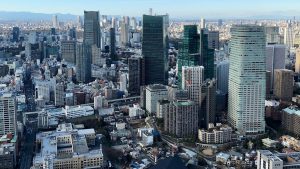 Solar power for a greener life for the planet and the home: Introduction of a new system for the mandatory installation of photovoltaic power generation
Solar power for a greener life for the planet and the home: Introduction of a new system for the mandatory installation of photovoltaic power generation
Amid concerns about the further worsening of the climate crisis and the prolonged impact of the energy crisis, the Tokyo Metropolitan Government, as a significant energy consumer, has set the goal of reducing the city’s greenhouse gas emissions by 50% by 2030 and increasing the proportion of electricity generated from renewable energy sources to around 50%. The Tokyo Metropolitan Government has also set a target to reduce greenhouse gas emissions in Tokyo by 50% by 2030 and to increase the share of electricity from renewable energy sources to around 50%.
Against this background, the Tokyo Metropolitan Government will introduce a new system (Building Environmental Reporting System) in April 2025, which will require installing photovoltaic power generation equipment in new homes, etc. and ensure thermal insulation and energy-saving performance.
This article provides an overview of the new system to realise the Tokyo Metropolitan Government’s goal of establishing the foundations for a decarbonised society and ensuring energy security.
Background
In Tokyo, 70% of CO2 emissions come from building energy use. As of 2050, approximately half of the building stock (70% for residential buildings) is expected to be replaced by newly constructed buildings, making it extremely important to take measures for new buildings, which will shape the shape of Tokyo in 2050.
On the other hand, the proportion of photovoltaic power generation equipment installed on residential roofs in Tokyo is limited at 4.24% in FY2021, so making maximum use of the unique strengths of the metropolis of Tokyo – its roofs – is a significant key to reducing CO2 emissions.
In addition, as energy consumption in the household sector in 2020 will be the only sector to increase compared to 2000 (by industry), further strengthening measures for the household sector is necessary.
Outline of the system
Under the scheme, major housing suppliers with an annual gross floor area of 20,000 m2 or more in Tokyo must install solar panels and ensure thermal insulation and energy-saving performance. New buildings are eligible; existing properties are not. The system is designed to promote the improvement of the environmental performance of buildings by suppliers, who are obliged to install the panels, together with owners of custom-built houses and buyers of built-for-sale houses.
Three significant benefits can be expected from installing solar panels under this scheme. The first is economic: monthly utility bills can be reduced, and income from the sale of electricity can be earned. Suppose 4 kW solar panels are installed on a detached house with a monthly electricity bill of around 10 000 yen. In that case, the initial cost can be recovered in approximately ten years (6 years with the current subsidy). In addition, a comparison of expenditure and income over 30 years shows a benefit of up to JPY 1,590,000. Secondly, on the environmental front, the panels can contribute to CO2 reduction: the CO2 reduction from 4 kW of solar power is equivalent to the absorption of 2,000 m2 of cedar forest (approximately 200 trees); thirdly, on the disaster preparedness front, the panels can provide electricity in the event of a power failure. The third is disaster preparedness, which enables electricity use during a power failure. During a power failure, information can be gathered, and safety confirmed via TV and smartphones.
Other benefits of the new system will encourage the development of products and services by operators to further demonstrate the advantages of solar power. In addition, houses with photovoltaic power generation equipment will become more standardised, increasing the number of options available to metropolitan residents.
Schedule for the introduction of the scheme
The system was approved and passed at a regular session of the Tokyo Metropolitan Assembly in April 2022, with a two-year preparation and awareness-raising period from 2023 to 2024, after which the system is scheduled to take effect in April 2025.
Trends in implementing solar PV obligations in overseas cities, local authorities in Japan, etc.
In the EU, as part of the European Rooftop Solar Strategy, the 2030 target for introducing renewable energies will be raised from 40% to 45%, and installing solar power generation equipment on buildings will become mandatory in stages by 2029.
In Germany, the introduction of mandatory photovoltaic ordinances is progressing in state governments. Regulations vary from state to state, with the state of Berlin mandating the installation of photovoltaic power generation in residential buildings from 1 January 2023.
In Japan, Kyoto Prefecture and Kyoto City have made the installation of solar power generation mandatory for new buildings and extensions with a total floor area of 300 m2 or more in 2022, while Gunma Prefecture has made it compulsory for new buildings and extensions with a total floor area of 2,000 m2 or more to install solar power generation from April 2023.
The Tokyo Metropolitan Government will further promote efforts to realise a more resilient, prosperous and liveable city with disaster resilience, durability and resilience by drastically strengthening, thoroughly and accelerating climate change countermeasures towards the realisation of a decarbonised society.
For more information on this programme, please click the link below (use a web browser extension or the Google Translate extension for English):

